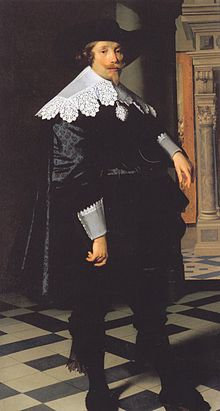Nicolaes Eliaszoon Pickenoy
Nicolaes Eliaszoon Pickenoy (born January 10, 1588 ; † 1653/1656) was a Dutch painter of Flemish origin. Pickenoy may have been a pupil of Cornelis van der Voort and Bartholomeus van der Helst was a pupil of Pickenoy.
Life
He was the son of Elias Claeszoon Pickenoy (1565-1640) and Heijltje Laurens s'Jonge (1562-1638), who emigrated from Antwerp to Amsterdam before he was born . In 1621, when he lived near the Oude Kerk , he married Levijntje Bouwens (1599 to around 1656), a 21-year-old orphan. They had ten children, two of whom, Sara and Elias, died young.
Pickenoy painted large rubbers , group portraits of the administrators of the orphanage, and individual portraits of local or national celebrities such as Nicolaes Tulp , Cornelis de Graeff , Maarten Harpertszoon Tromp and Jochem Hendrickszoon Swartenhont, husband of Elisabeth Bas. The earliest picture attributed to Pickenoy is "Dr. Sebastiaen Egbertz de Vrij's Osteological Presentation" from 1619, it is now in the Amsterdam Museum . The high point of his work was the period from 1630 to 1637, a period that was characterized by a high artistic level and numerous commissions from prominent patrons. Another large painting from the Amsterdam Museum's collection is The Meal of the Riflemen from the company of Captain Jacob Backer and Lieutenant Jacob Rogh from 1632 to 1634.
After 1637 he painted very little, except for a few prestigious and lucrative group portraits. Apart from portraits, he also painted a small number of biblical motifs, which can be viewed in the Catharijneconvent Museum. The Rijksmuseum Amsterdam and the Amsterdam Historisch Museum own many of his best works. In 1637 he bought the house from Adriaen Pauw on the corner of Sint Anthoniessluis and Jodenbreestraat, an area where many painters, art dealers and jewelers were based. The house had previously belonged to his presumed teacher, Cornelis van der Voort , and was later bought by Hendrick van Uylenburgh . The latter worked with Rembrandt van Rijn between 1631 and 1634 . In 1639 Rembrandt bought the neighboring house Pickenoys, today's Museum Het Rembrandthuis . Like Rembrandt, Pickenoy could not pay the loan for his house and had to sell the house again after eight years.
Pickenoy's works are not easily distinguished from some of his contemporaries. Characteristic of Pickenoy's style are the sharp incidence of light, which make the heads stand out sharply, the somewhat exaggerated gestures, the large, greenish-brown shadows and the unusually shaped eyes.
literature
- Oosthoek's Geïllustreerde Encyclopedia (1917)
- SAC Dudok van Heel: De schilder Nicolaes Eliasz. Pickenoy en zijn family . Liber Amicorum voor Jhr MCC van Valkenburg, 1985, pp. 152-60.
- David Burmeister Kaaring: Nicolaes Eliasz Pickenoy (1588–1650 / 56) and Portraiture in Amsterdam around 1620–45 . In: SMK Art Journal 2005 . Pp. 127-137 [1] . (For illustrations see: Nicolaes Eliasz Pickenoy (1588–1650 / 56) og den amsterdamske portrætkunst, approx. 1620–45 . In: SMK Art Journal 2005. pp. 60–81) [2]
Web links
- Nicolaes Eliaszoon Pickenoy at Google Arts & Culture
- Four portraits in the Rijksmuseum
- The corporal body of Jan Claesz Vlooswijck (Dutch)
- Artist entry of the RKD about Pickenoy, with numerous pictures on the left (English)
| personal data | |
|---|---|
| SURNAME | Pickenoy, Nicolaes Eliaszoon |
| BRIEF DESCRIPTION | Dutch painter of Flemish origin |
| DATE OF BIRTH | January 10, 1588 |
| DATE OF DEATH | 1653 or 1656 |

